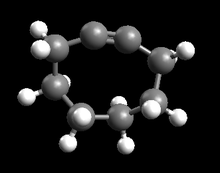
| |

| |
| Identifiers | |
|---|---|
3D model (JSmol)
|
|
| 1209275 | |
| ChEBI | |
| ChemSpider | |
PubChem CID
|
|
| UNII | |
CompTox Dashboard (EPA)
|
|
| |
| |
| Properties | |
| C8H12 | |
| Molar mass | 108.184 g·mol−1 |
Except where otherwise noted, data are given for materials in their standard state (at 25 °C [77 °F], 100 kPa).
| |
Cyclooctyne is the cycloalkyne with a formula C
8H
12. Its molecule has a ring of 8 carbon atoms, connected by seven single bonds and one triple bond.
Cyclooctyne is the smallest cycloalkyne that is stable enough to be isolated, although the chemical is still highly reactive. The alkyne region of the structure attempts to adopt a linear molecular geometry, but the nature of the ring creates substantial ring strain. As a result, cyclooctyne and other compounds containing this ring structure readily react in ways that reduce the ring strain by converting the alkyne to a functional group that does not require linear geometry. An important application of this reactivity is in click chemistry, where cyclooctynes undergo cycloaddition reactions with azides[1] or nitrones,[2] forming triazoles or isoxazolines, respectively.
References[edit]
- ^ Baskin, J. M.; Prescher, J. A.; Laughlin, S. T.; Agard, N. J.; Chang, P. V.; Miller, I. A.; Lo, A.; Codelli, J. A.; Bertozzi, C. R. (2007). "Copper-free click chemistry for dynamic in vivo imaging". Proceedings of the National Academy of Sciences. 104 (43): 16793–7. Bibcode:2007PNAS..10416793B. doi:10.1073/pnas.0707090104. PMC 2040404. PMID 17942682.
- ^ Ning, Xinghai; Temming, Rinske P.; Dommerholt, Jan; Guo, Jun; Blanco-Ania, Daniel; Debets, Marjoke F.; Wolfert, Margreet A.; Boons, Geert-Jan; Van Delft, Floris L. (2010). "Protein Modification by Strain-Promoted Alkyne-Nitrone Cycloaddition". Angewandte Chemie International Edition. 49 (17): 3065–8. doi:10.1002/anie.201000408. PMC 2871956. PMID 20333639.
External links[edit]
 Media related to Cyclooctyne at Wikimedia Commons
Media related to Cyclooctyne at Wikimedia Commons